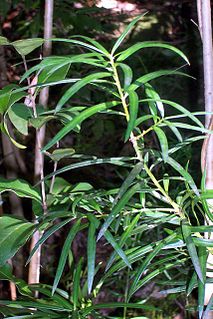
Podocarpus spinulosus, the dwarf plum pine or spiny-leaf podocarp, is a species of podocarp native to the warm-temperate coastal regions of New South Wales and southern Queensland. It is generally an understorey shrub, rarely growing more than 2 m tall.

Floydia is a monotypic species of tree in the family Proteaceae native to Australia. It is a somewhat rare tree found only growing in the rainforests of southeastern Queensland and northern New South Wales. The sole species is Floydia praealta which is commonly known as the ball nut or possum nut.

Austromyrtus is a genus of shrubs in the myrtle family Myrtaceae. Three species are found along the east coast of Australia; in Queensland and in New South Wales and A. lotoides being endemic to New Caledonia. The fruits of A. dulcis have a hint of cinnamon flavouring. The species under this generic name in New Caledonia are being taxonomically revised and will be transferred to another genus.

Pherosphaera fitzgeraldii, commonly known as the Blue Mountains pine or dwarf mountain pine is a species of conifer in the family Podocarpaceae. It is found only in New South Wales, Australia. The entire natural habitat is in the Blue Mountains, from Katoomba to Wentworth Falls, growing almost exclusively in the splash zones of waterfalls, and on the southern aspect of sandstone nearby.

Grevillea barklyana, also known as gully grevillea or large-leaf grevillea, is a tree which is endemic to an area near Labertouche, Victoria in Australia.
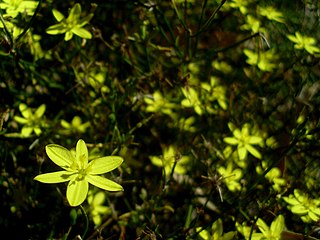
Tricoryne is a genus of perennial herbs in the family Asphodelaceae, subfamily Hemerocallidoideae. All species are native to Australia with two species extending to New Guinea; within Australia they occur in all 6 states and the Northern Territory.
- Tricoryne ancepsR.Br. - New Guinea, Queensland
- Tricoryne corynothecoidesKeighery - Western Australia
- Tricoryne elatiorR.Br. - Yellow Rush-lily - all 6 states plus Northern Territory
- Tricoryne humilisEndl. - Western Australia
- Tricoryne muricataBaker - Queensland
- Tricoryne platypteraRchb.f - New Guinea, Queensland
- Tricoryne simplexR.Br. - New South Wales
- Tricoryne tenellaR.Br. - Mallee Rush-lily - Western Australia, South Australia

Trichodesma zeylanicum, commonly known as camel bush or cattle bush, is a herb or shrub native to Australia.

Callistemon 'Lilacinus' is a cultivar of the genus Callistemon. It grows to between 2.5 and 4 metres high and has purplish-violet inflorescences. Leaves are smooth and sharp pointed, with thick margins and are 40 to 100 mm long and 6 to 18 mm wide.

Xanthorrhoea arborea a species of grasstree of the genus Xanthorrhoea native to New South Wales and Queensland. It was one of the many species authored by the Scottish botanist Robert Brown.

Xanthorrhoea minor is a species of grasstree of the genus Xanthorrhoea native to south-eastern Australia. It was one of the many species authored by the Scottish botanist Robert Brown.

Calochlaena dubia, commonly known as soft bracken, false bracken, common ground fern or rainbow fern, is a small Australian fern in the treefern family Dicksoniaceae. It is very common within its range, and often seen growing under eucalyptus forest, often on the poorer quality soils. It is an easy plant to grow in the garden.

Hedraianthera is a genus of a sole recognised species of shrubs or small trees endemic to Australia from the family Celastraceae.

Callerya megasperma, also known as native wisteria, is a species of vine in the family Fabaceae native to eastern Australia. It was initially described as Wistaria megasperma by Ferdinand von Mueller in 1859 from a specimen collected at Richmond River.
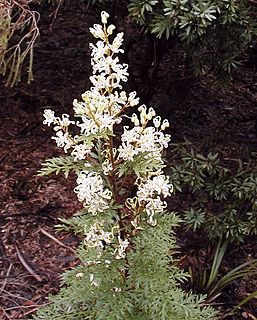
Lomatia silaifolia, commonly known as crinkle bush or parsley fern, is a plant of the family, Proteaceae native to eastern Australia. Naturally found in open forest, it grows as a small shrub 1–2 m high with highly pinnate leaves reminiscent of parsley. The white inflorescences appear in summer.
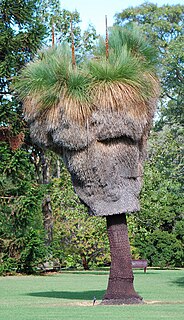
Xanthorrhoea malacophylla is a species of grasstree of the genus Xanthorrhoea. It is endemic to New South Wales, Australia. Mature plants form a single or branched trunk that ranges between 2 and 6 metres in height. The grass-like leaves, which are usually around 3 mm wide, are distinguished from other species by their softness and sponginess. The flowers appear between May and September in scapes that are between 1.3 and 1.8 metres long.
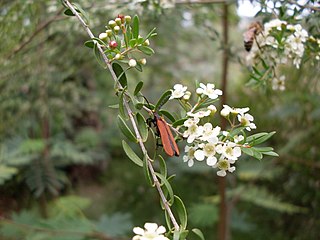
Sannantha pluriflora, commonly known as tall baeckea, is a flowering shrub or small tree species in the myrtle family, Myrtaceae. It is endemic to Australia. Plants grow to 4 metres high. White flowers appear in groups of three to seven between October and April in the species' native range. These have five rounded petals surrounding 8–15 stamens. The fruits are 2.5 to 3.5 mm in diameter.

Allocasuarina inophloia, also known as woolly oak, or stringybark she-oak, is a shrub or small tree of the she-oak family Casuarinaceae endemic to inland New South Wales and Queensland. The hairy bark is an unusual feature.

Lomatia arborescens, commonly known as smooth lomatia or tree lomatia, is a shrub or small tree that grows at high altitudes, in and near rainforests. It is found north from the Barrington Tops area in eastern Australia.

Eriocaulon scariosum, commonly named common, rough or pale pipewort, is a species of tufted grass-like herbaceous plants, constituting part of the plant family Eriocaulaceae. Common pipewort plants grow naturally in wetlands, bogs and drainage areas, from central and eastern Victoria, through eastern New South Wales, including the Australian Capital Territory, to eastern and north Queensland, Australia.
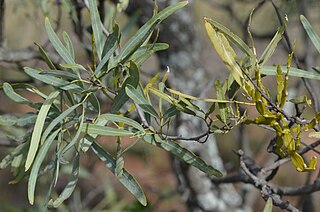
Korthalsella rubra is a flowering plant in the Santalaceae (sandalwood) family, formerly placed in the Viscaceae.




















